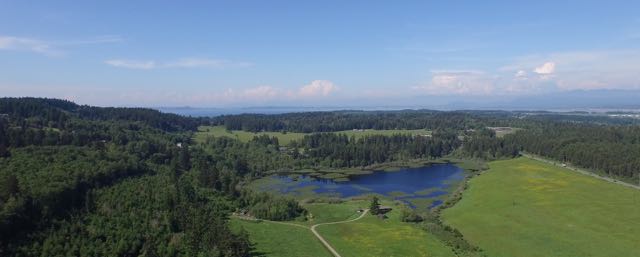
When Kristoferson Farm was purchased in 1912, the forest had been largely clear-cut. Cedar stumps bearing the notches of the early logger’s scaffold remain to this day. Timber has always been a component of the farm providing the wood for the many of the original structures. The approximately 100 forested acres on the property today are managed for timber according to a Forest Stewardship Plan developed with Washington State University. The Kristoferson Farm forest is recognized as a Certified American Tree Farm for meeting the Standards of Sustainability.
A 180-year plan
Dividing the forest into stands, groups of trees with similar species composition and logging history; we developed a timetable of forest practices including harvests. A 180-year rotation on 100 acres involves harvesting 10-acre stands every 20 years leaving one stand to continue growing. This harvest rotation allows most trees to reach 180 years old. At any given time, there is a wide range of tree maturity across the entire forest. Age differentiation and spatial diversity maximize plant and animal diversity too.
Implementation, old-growth in the making
One of the first actions of our Forest Stewardship Plan was to harvest a stand of red alder in decline, sparsely populated with trees, and dominated by shrubs like salmonberry and blackberry. In 2005, thousands of Douglas fir, western hemlock and western red cedar were planted to reestablish a conifer forest. These trees will not be harvested in our lifetime. To encourage wildlife diversity, Kristoferson family members planted five other tree species native to the Northwest including Pacific yew, Pacific madrone, grand fir, Sitka spruce and Alaska cedar.
Improving fish habitat and passage
Since 2008, a number of projects along Kristoferson Creek, a salmon bearing stream running through the valley of the farm, have improved fish habitat and removed barriers to fish passage. These projects include 2 bridges and a hardened crossing replacing undersized and dilapidated culverts and an effort to reestablish native trees and shrubs along 1/4 mile of the creek corridor. This planting effort was completed in 2008 with the hard work of family and community volunteers. All of these improvements were made possible in partnership with Snohomish Conservation District, Natural Resource Conservation Service, Farm Service Agency, Department of Natural Resources, Washington Department of Fish and Wildlife, and the local community.
We are pleased to report seeing fish returning to Kristoferson Creek, an important salmon (including the endangered Chinook) rearing habitat on Camano Island.
Farm and forest conserved forever
Working with the Whidbey Camano Land Trust, the Kristoferson family granted conservation easements on the property in 2023. The easements will insure the property will not be commercially developed, and will remain a farm and forest, subject to environmental protection in perpetuity.
We are six generations of family who since 1912 have owned and managed our farm on Camano Island. Our mission is to preserve the farm and it's abundant wildlife for our family and community.
